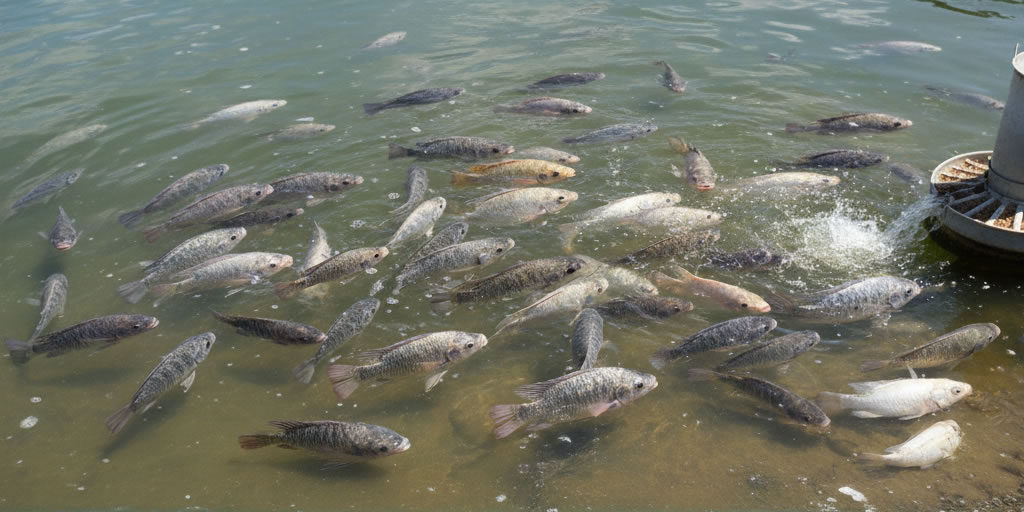- Software Gestor para Aquicultura
- (85) 2139-6730
- contato@despesca.com.br
Early Detection: How to Identify Signs of Stress and Disease in Fish and Shrimp and Act Fast

Cash Flow in Aquaculture: How to Plan for the Off-Season and Maintain Financial Health
28/08/2025
The Complete Guide to Biosecurity in Aquaculture: From Checklist to Action
01/09/2025In aquaculture, the success of a production cycle is directly linked to the farmer’s ability to maintain a healthy and stable environment for the animals. The early detection of any sign of stress or disease is crucial to prevent significant losses. Problems that start with a few individuals can quickly spread throughout the entire pond if not identified and corrected in time. Therefore, daily observation and systematic data recording are the main tools for proactive and efficient health management.
Behavioral Signs: The First Alert
The behavior of the animals is often the first indicator that something is wrong in the cultivation environment. Subtle changes in routine can signal everything from water quality issues to the onset of an illness.
- Lethargy or Erratic Swimming: Fish that appear apathetic, motionless at the bottom of the pond, or exhibit disoriented swimming and sudden movements are clearly in distress. In shrimp, reduced activity, especially during feeding times, is a warning sign. These behaviors are often associated with low levels of dissolved oxygen or the presence of toxic nitrogenous compounds, such as ammonia and nitrite.
- Loss of Appetite: A reduction or refusal to eat feed is one of the most universal and reliable indicators of problems. If the animals are not feeding with their usual vigor, it is a clear sign of stress. The cause can range from poor water quality to bacterial or viral infections.
- Atypical Grouping: It is important to observe the distribution of animals in the pond. Fish grouped at the surface, “gasping” for air (a movement known as piping), indicate a severe oxygen deficiency. Similarly, fish or shrimp concentrated near water inlets or aerators also signal a search for better environmental conditions.

Visible Physical Changes: Signs That Cannot Be Ignored
When the signs become physical and visible on the animals’ bodies, the problem may be at a more advanced stage. Action needs to be even faster.
- Changes in Coloration: Darkening or paling of the fish’s skin are common physiological responses to stress. In shrimp, changes in coloration, such as the appearance of reddish tones or dark spots on the carapace, can indicate environmental stress or infections.
- Lesions and External Abnormalities: The presence of wounds, ulcers, eroded fins, white spots (suggestive of ich in fish), or cotton-like tufts (indicative of fungus) are clear signs of disease. In shrimp, the carapace may show erosion or necrosis.
- Swelling and Exophthalmia: Abdominal swelling (ascites) or bulging eyes (exophthalmia) in fish are often symptoms of systemic bacterial infections or osmotic problems.
Rapid Action: What to Do?
Upon identifying any of the mentioned signs, the first action should always be the same: measure the water quality parameters. Immediately check the levels of dissolved oxygen, pH, temperature, ammonia, and nitrite.
- Water Problems: If a parameter is found to be outside the ideal range, take immediate corrective measures. Turn on emergency aerators in case of low oxygen, initiate a controlled water exchange to dilute toxic compounds, or make pH corrections if necessary.
- Suspected Disease: If the water parameters are normal, the focus shifts to a possible pathology. Suspend feeding to reduce waste production and the metabolic stress on the animals. Collect samples of affected individuals for laboratory analysis or consult a specialized technician for an accurate diagnosis. Avoid the indiscriminate use of medications without a proper diagnosis.
The Role of Data Management
The ability to act quickly depends on the quality of the available information. Using management software, such as Despesca, transforms daily observation into strategic data. Systematically recording feed consumption, animal behavior, and water parameters creates a historical baseline. Any deviation from this pattern becomes easily identifiable, allowing the farmer to act before the problem worsens. The analysis of this data even allows for predicting periods of higher risk and optimizing management to prevent the occurrence of stress and diseases, ensuring the health and profitability of the farm.




